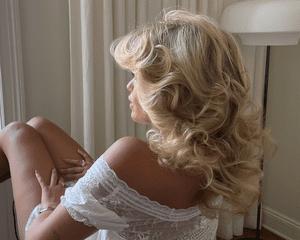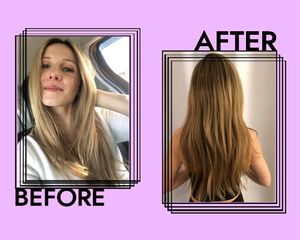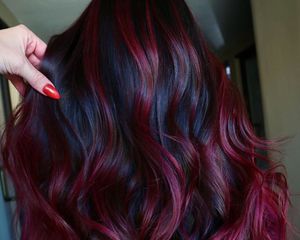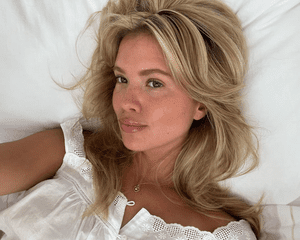:max_bytes(150000):strip_icc()/Stocksy_txpe21661e5axK300_Medium_2868417-bd1836970218460aa3b887c54488e9c5.jpg)
Javier DÃez / Stocksy
Whether your highlights were a spur-of-the-moment decision or a gradual process, there often comes a time where you’re generally over them and eager to get rid of them. Perhaps it was the battle against brassy tones that broke you, or the sudden change in the health of your strands—purple shampoo and deep conditioning treatments can only pull so many heroics, after all. Maybe you’re simply sick color as a whole and want to return to your roots.
That’s why we asked hairstylist Trey Gillen and colorist Larisa Love about some of the most effective methods for getting rid of your highlights, what each treatment entails, and the pros and cons of every route. Keep reading to learn more about each of the five methods, and how to determine the best method for you.
Meet the Expert
- Trey Gillen is a hairstylist, color specialist, and the Artistic Director of education at SACHAJUAN with over a decade of experience in the hair industry.
- Larisa Love is a colorist, hairstylist, and Joico brand ambassador. She is the founder of Larisa Love Salon in Los Angeles, and has over ten years of experience.
Add Lowlights
Want to tone down the intensity of your highlights, while still keeping some dimension? Lowlights may be the answer. “Lowlighting is a process where you can either foil or Balayage darker pieces into your blonde hair,” says Gillen. “This adds richness and darkness to your blonde highlights without completely covering up all your blonde.” Placement is key, so Gillen recommends going to a professional if you choose this route.
PROS: If you’re on the fence about whether or not to fully get rid of your highlights, but definitely want them to be tone down, lowlights are a happy medium. “If you have doubts and you’re not sure if you want to go darker, this is a good way to test the waters,” says Gillen. “You can always reverse the lowlights the next time you’re in the salon.” It’s also a relatively quick process. Gillen notes that lowlights typically take 30 minutes to place and another 30 minutes to process.
CONS: “They won’t get rid of your highlights altogether, but they will definitely reduce how bright the overall effect is depending on how many lowlights you add,” Gillen says.
Shadow Root or Color Melt
“A shadow root technique adds depth just to the base and root-area of your hair,” Gillen says. “Color melts add darkness and depth even lower into the root and mid lengths of your hair.” While a color melt can be thought of almost as a reverse-ombre, a shadow root concentrates the depth around the base to diminish the appearance of highlights directly in the root area, and ensures the color grows out gracefully, as it helps fade that line of demarcation. “Both of these techniques add depth and richness at the root area, will give you more freedom and time in between highlighting if you want to keep your blonde, and create a more lived-in look.”
PROS: This method is ideal if you want to keep a few bright pieces around your face, but prefer a darker base color. “The goal here is to add depth to the top portion of your hair,” Gillen says. It’s also a relatively quick technique, as Gillen notes that, while placement is important and should be specific, your colorist will generally do this process as you’re in the shampoo bowl, taking about 30 minutes in total.
CONS: Like lowlights, the color melt and shadow root methods won’t remove the highlights entirely, but can help tone down the overall effect by adding a deeper base color. “It won’t completely reduce the brightness of your blonde highlights—you’ll still be able to see them,” Gillen says. Additionally, the deeper color will be concentrated around the top of your head, so a combination between these techniques and lowlights may be required if you want to continue the hue all over.
Use a Darker Gloss or Toner
According to Gillen, this route is essentially a color correction, and is highly effective if you want to keep your length while removing the bright tones—just make sure you ask your colorist for a multi-dimensional finish, and that your hair is filled correctly with the color for longer-lasting results. “Filling the hair means that you’re replacing the color that the bleach has stripped out from going blonde,” Gillen says. “You’d start with that, and once the hair has been filled, you’d move on by applying the desired darker tone.” While it’s possible to DIY it, Gillen recommends going to a professional to ensure your hair maintains dimension, and the finished result isn’t a flat, monotone box-dyed effect.
PROS: “When your gloss or toner is done correctly, it will completely get rid of your highlights, at least for a period of time,” Gillen says. Additionally, hair glosses and toners can help to give your hair a shinier, healthier appearance, and according to Love, can take about 20 minutes from start to finish, so it’s a quick process.
CONS: “While going the gloss route is effective, it’s not a fully permanent solution to getting rid of your highlights,” Love says. “The color will slowly start to fade with each wash.” Using a gloss or toner is definitely something that you’ll need to maintain if you don’t want the highlights to return to their brighter state. A recommended at-home gloss or color depositing conditioner from your colorist may buy you extra time between appointments, but for the full overhaul, you’ll need to visit your stylist for a touch-up after a few weeks.
Cut Off the Highlights
One surefire way to keep your highlights from fading back to their brighter state? Cutting them off entirely. “With this process, you would come into the salon and get your stylist to completely cut off all of your blonde hair, and resort back to your natural regrowth for a healthier, natural look,” Gillen says. “This method would be more along the lines of a haircut appointment. Your hairstylist would do a consultation with you before getting shampooed to see whether or not a pre-cut is necessary, and to discuss exactly how short your hair will end up so you don’t have any regrets about cutting off your length.”
PROS: Aside from getting a fancy new haircut, your strands will be in a healthier state almost immediately. “You’ll be getting rid of all the damage,” Gillen says. “By cutting off all the blonde, you’re returning your hair immediately to a very healthy state.” Additionally, since the highlights will be completely gone, you won’t have to fuss with color-depositing conditioners or glosses afterwards.
CONS: “If you love your long hair and don’t want to lose out on your length, this wouldn’t be a good option for you,” Gillen says. The same can be said with those who have short to medium-length hair with highlights that span large areas of your hair. Depending on how prominent your color is, cutting all of it off may not be entirely possible without resulting in a super-short style.
Use Permanent Color
Similar to using a hair gloss, Love notes that with the permanent route, your hair will be completely covered from root to tip with the color to ensure no areas are missed. The main difference here? Unlike a gloss, permanent color won’t fade as you wash your hair, and is a pretty quick and effective process. “Permanent color will take about 35 to 45 minutes to process, and should take around an hour and a half in total with blow-drying and styling,” she says.
PROS: Permanent color has more staying power than the rest of the methods. “Going the permanent route lasts much longer than a gloss,” Love says. “A gloss is effective, but will fade with each wash, which won’t happen with the permanent color.” This method may be low-maintenance if you don’t want to keep up with regular gloss treatments, and are fully committed to sticking with the color in question.
CONS: Changing up your color, should you decide to do so in the future, can be a somewhat difficult task. “If you eventually want to go lighter again, your stylist will have to break through the permanent color,” Love says. Depending on how dark the permanent hue is, this often requires some aggressive lifting with bleach, which can damage hair when not done gradually.












